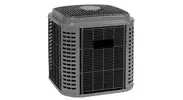Loading ...
Loading ...
Loading ...

|
Split
System
Condensers
Installation
Instructions
J
Recommended
Method
Of
Evacuating
A
System
1.
Connect
the
vacuum
pump
to
the
suction
and
liquid
line
gauge
ports.
2.
If
the
evacuation
is
being
performed
on
a
new
system
installation,
the
valves
should
be
kept
in
the
"front
seated”
(closed)
position.
This
will
allow
the
mechanic
to
evacuate
the
refrigeration
lines
and
the
indoor
coil,
without
disturbing
the
factory
charge
in
the
outdoor
unit.
3.
Follow
the
vacuum
pump
manufacturer’s
instructions.
Allow
the
pump
to
operate
until
the
system
has
been
eva-
cuated
down
to
300
microns.
Allow
the
pump
to
continue
running
for
an
additional
15
minutes.
Turn
off
the
pump
and
leave
the
connections
secured
to
the
two
service
valves.
After
5
minutes,
if
the
system
fails
to
hold
500
microns
or
less,
check
all
connections
for
tight
fit
and
repeat
the
evac-
uation
procedure.
4.
Isolate
the
vacuum
pump
from
the
system
by
closing
the
shutoff
valves
on
the
gauge
bar.
Disconnect
the
vacuum
pump.
Valve
Actuation:
Service
Valves
Remove
the
service
valve
cap,
if
there
is
a
male
valve
stem
see
instructions
for
Ball
Valves.
For
the
standard
service
valve
there
are
two
variations,
but
both
have
internal
stems.
The
first
style
uses
an
internal
snap
ring
to
retain
the
valve
stem
and
the
second
has
a
rolled
top
and
also
has
finer
threads
on
the
valve
cap.
NOTE:
You
may
encounter
more
than
one
type
of
valve
on
a
unit.
For
service
valves
fully
insert
a
hex
wrench
into
the
stem.
A
back-up
wrench
is
required
on
the
valve
body
to
open
the
valve
stem.
Backout
counterclockwise
until
the
valve
stem
stops
or
just
touches
the
retaining
ring.
NOTE:
THIS
IS
NOT
A
BACKSEATING
VALVE.
For
valves
with
retainer
rings
care
must
be
taken
to
prevent
dislodging
them
when
opening
valve.
Electrical
Wiring
The
service
valve
cap
is
a
primary
seal
for
the
valve
and
must
be
properly
tightened
to
prevent
leaks.
Make
sure
cap
is
clean
and
apply
refrigerant
oil
to
threads
and
sealing
sur-
face
of
cap.
For
valves
with
retaining
rings:
Replace
service
valve
cap
and
torque
to;
8-11
ft.
Ibs.
on
1/4”
and
3/8”
valves,
12-16
ft.
lbs.
on
5/8”
and
3/4”,
15-21
ft.
los
on
7/8”
valves.
If
torque
wrench
is
not
available,
tighten
cap
finger
tight
and
then
tighten
one
(1)
additional
wrench
flat
or
1/6
of
a
turn.
For
valves
with
rolled
tops:
Replace
service
valve
cap
tighten
cap
finger
tight
and
then
tighten
one
(1)
additional
wrench
flat
or
1/6
of
a
turn
to
properly
seat
the
sealing
sur-
faces.
Subsequent
installations
will
seat
with
1/2
to
1
wrench
flat
of
turning.
Gauge
Ports:
All
Valves
Check
for
leaks
at
the
schrader
port
and
tighten
valve
core
if
necessary.
Install
plastic
caps
finger
tight.
Ball
Valves
On
models
with
ball
type
valves
use
a
6”
crescent
wrench
to
rotate
the
valve
stem
90°
counter
clockwise.
Retighten
valve
cap
to
6-8
ft.
lbs.
If
torque
wrench
is
not
available,
tighten
cap
finger
tight
and
then
tighten
one
(1/2)
additional
wrench
flat.
REFRIGERATION
PIPING
&
CHARGING
For
extended
piping
over
the
recommended
75
feet
please
refer
to
Extended
Length
Refrigerant
Piping
Manual
(Part#
42106111400).
Electrical
Shock
Hazard.
Shut
off
electric
power
at
fuse
box
or
service
pan-
el
before
making
any
electrical
connections.
Failure
to
shut
off
electric
power
can
result
in,
property
damage,
personal
injury
and/or
death.
The
supply
voltage
should
be
208-230
volts
(196
volt
mini-
mum
to
253
volts
maximum)
60Hz
single
phase.
APPROVED
FOR
USE
WITH
COPPER
CONDUCTORS
ONLY.
DO
NOT
USE
ALUMINUM
WIRE.
REFER
TO
UNIT
RATING
PLATE
FOR
CIRCUIT
PROTECTION.
Grounding
Permanently
ground
unit
in
accordance
with
the
National
Electrical
Code
and
local
codes
or
ordinances.
Use
a
cop-
per
conductor
of
the
correct
size
from
the
grounding
termi-
nal
in
control
box
to
a
grounded
connection
in
the
service
panel
ora
properly
driven
and
electrically
grounded
ground
rod.
Wiring
Connections
Make
all
outdoor
electrical
supply
(Line
Voltage)
connec-
tions
with
raintight
conduit
and
fittings.
Most
codes
require
a
disconnect
switch
outdoors
within
sight
of
the
unit.
Route
Line
Voltage
wiring
through
hole
in
the
bottom
of
the
Control
Box
and
around
the
side
of
the
shelf
to
connect
to
Contactor
and
Ground
Lug.
Route
Low
Voltage
wiring
through
entrance
in
bottom
of
control
box and
make
ALL
low
voltage
connections
to
the
low
voltage
pigtails
in
the
area
created
by
the
shelf
and
the
low-volt
shield.
(Two
Yellow
wires,
AC
or
W,Y,O,BL,
&R
for
HP).
The
pigtail
wires
have
600V
insulation
meeting
ap-
proval
for
use
in
high
voltage
areas.
27]
Loading ...
Loading ...
Loading ...
